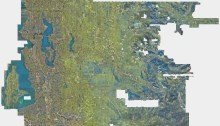2019 Aerial Imagery: from camera to map
As King County was taking delivery of the 2019 digital imagery data from its vendor, EagleView Technologies, GIS analysts, cartographers, and software engineers across King County government, plus users of our GIS products throughout the area, anxiously awaited the creation, from the delivered data, of a variety of secondary imagery products for use in their analyses, maps, and applications.









